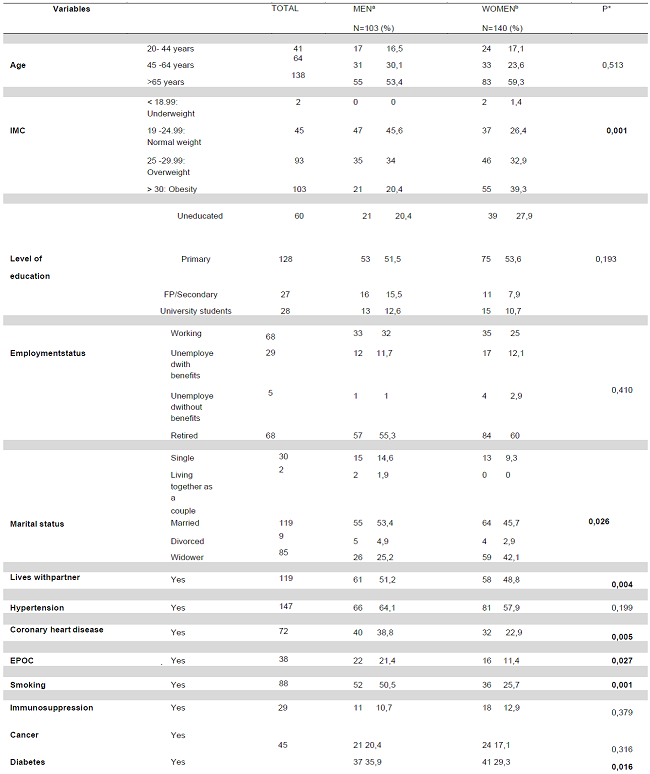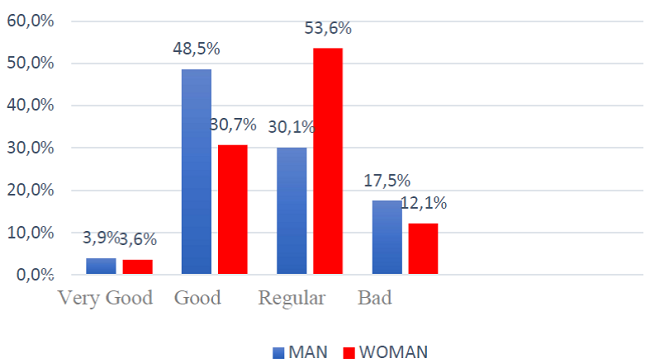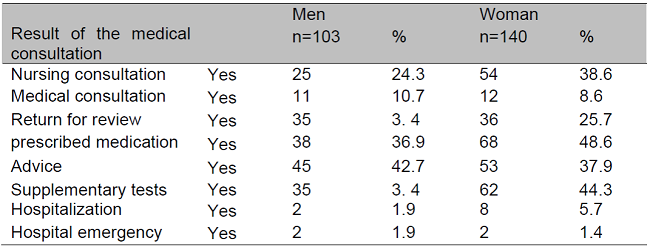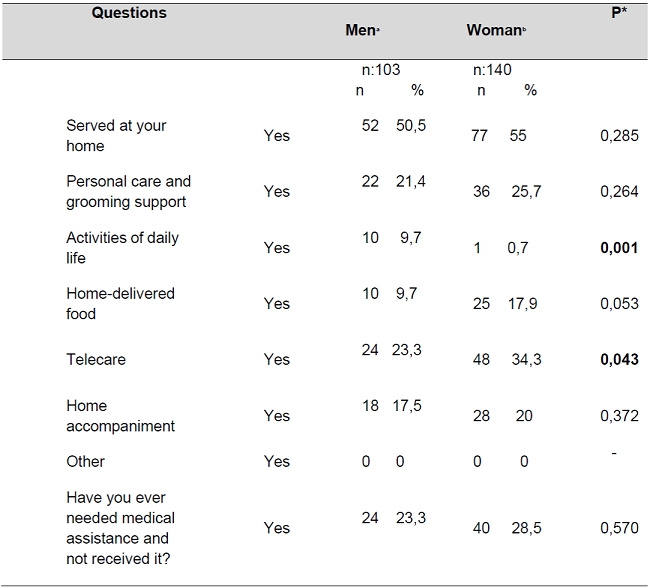My SciELO
Services on Demand
Journal
Article
Indicators
-
 Cited by SciELO
Cited by SciELO -
 Access statistics
Access statistics
Related links
-
 Cited by Google
Cited by Google -
 Similars in
SciELO
Similars in
SciELO -
 Similars in Google
Similars in Google
Share
Enfermería Global
On-line version ISSN 1695-6141
Enferm. glob. vol.22 n.69 Murcia Jan. 2023 Epub Mar 20, 2023
https://dx.doi.org/10.6018/eglobal.529701
Originals
Perception of health in patients during the COVID-19 pandemic
1Nursing Coordinator. Almoradí Health Center, Department of Health 21 SNS Orihuela. Alicante. Spain
2University of Alicante. Alicante. Spain. francisco.escandell@ua.es
Objective:
To analyze the perception of health in primary care patients of the health department 21 during the COVID-19 epidemic period.
Material and Methods:
Cross-sectional observational study. Held in the Department of Health 21 (Alicante-Spain) from February 23, 2021, to May 15, 2021. A total of 243 users participated. A semi- structured interview was used, taking as a reference the information from the Valencian Community Health Survey Adapted. The variable result of the perception of health in patients was considered. The inclusion criteria considered 18-year-olds who were served during the COVID-19 pandemic and who wanted to participate in the study.
Results:
The ages were comprised between 20 and 94, years with an average of 64.55 years (SD 19.97). In the perception of health, we highlight the group of women who reported having a worse health (69%) during the last 12 months and major problems to walk (59.2%). Our results indicate a significant association in the social resources used for the activities of daily life (p<0.001) and teleassistance (p<0.043).
Conclusion:
On a practical level, if we have an account of life expectancy in the population, associated comorbidities and health care in the pandemic period, we can decide that the perception of health is worse in women. Despite all these factors, satisfaction with health services during the pandemic is satisfactory.
Keywords: primary care; perception; COVID-19; health determinants; health resources
INTRODUCTION
During the period of the COVID-19 pandemic there has been a significant overuse of health services in all health systems worldwide, with particular emphasis during the vaccination period on primary care 1. Telemedicine has been used almost constantly, with a loss of direct professional-user contact that IT technologies cannot replace 2. On-demand activities have surpassed any planning that has an impact on the implementation of preventive activities or on the technological accessibility barriers of certain socio-cultural groups 1,2.
The effectiveness of preventive interventions is enhanced by elements such as empathy, quality of the professional-patient relationship and warmth of clinical communication, aspects that are altered by care through electronic tools 2. It also opens opportunities for prevention that allow us to focus health services on the main health problems in the community and to provide the necessary promotion, prevention, treatment and rehabilitation services to solve these problems 3.
On the other hand, the pandemic, of a community nature, has favored the commitment of citizens to co-responsibility and the importance of empowerment in disease control, together with the perception that the health system alone is insufficient to prevent diseases 3. Technological development has great advantages, such as advances in medical records that make it possible to monitor lifestyles and improve people's health information systems, both in their homes and in their social environment, favoring selective and highly targeted interventions to prevent diseases 4.
Pandemics can have differential impacts on women and men, ranging from risk of exposure and biological susceptibility to infection to social and economic implications, and people's experiences are likely to vary according to their biological and gender characteristics and their interaction with other social determinants of health 5,6.
The global response to COVID-19 has been described as "too little, too late", with national and international efforts at an unplanned pace, in the face of many aspects of this situation that remain uncertain 7,8). However, this should serve to implement global protocols to prepare for future scenarios and enable us to be ready for similar situations. The World Health Organization (WHO) urges its Member States and all global actors to target investments in quality, gender- sensitive research on the adverse health, social and economic impacts of COVID- 19 7)(8)(9)(10)(11)(12)(13)(14)(15)(16. Advancing proposals for improvement includes further related research such as the one presented in this study that aims to analyze the health perceptions of primary care patients in health department 21 during the epidemic period of COVID-19.
METHODS
Study design and subjects
A cross-sectional observational study was conducted in a basic health area, which serves a total population of 26,195 inhabitants with a rural profile located in the south of the Valencian Community (Spain). The sample size reached was n=243 patients, the type of sampling was random stratified proportional by type of care/consultation in primary care.
Inclusion criteria: people over 18 years of age who were seen in the basic health area of study during the COVID-19 pandemic from 23 February 2021 to 15 May 2021 and who wished to participate in the study. Exclusion criteria: Cognitive disability and inability to respond.
Procedure
Health care from March 2020 was modified due to the pandemic and a change in the care model was implemented, agreed by consensus through protocols that indicated how health care should be provided. Patients were divided for care into patients presenting with respiratory symptoms and patients presenting with other pathologies. These were selected according to their appearance in the nursing diaries and their willingness to participate in the study.
Variables
A semi-structured interview was used, taking as a reference the information from the health questionnaire of the Valencian Community, adapted from (17). To complement the information, the digital medical history was used to extract comorbidity, height and weight. The perception of health in patients during the COVID-19 pandemic was considered as an outcome variable, and sex, age and socio-demographic characteristics as explanatory variables. In addition, the following covariates were taken into account: health consultations and social resources used.
Ethical considerations
Following a favorable report from the Research Ethics Committee (REC) of department 21, with registration code TFM-2021-010, participants were given an information sheet on the study and were asked to provide informed consent. The ethical principles for medical research on human subjects, as set out in the "Declaration of Helsinki", were considered as the mode of participation in the study and the use of personal data according to the Organic Law 3/2018, of 5 December, on the protection of personal data and guarantee of digital rights. The data are protected from use and not allowed to persons outside the research and are therefore considered strictly confidential.
Data analysis
A descriptive analysis of all the variables was carried out by calculating frequencies and percentages by sex. The male/female groups were calculated using contingency Tables, applying the Chi-square test to compare the variables of interest according to sex. To calculate the magnitude of association, the Odds Ratio (OR) was calculated with its 95%CI. All tests were considered significant if p<0.05. The following programs were used: database (Excel) and SPSS 25.0 statistics.
RESULTS
The total sample was 243 users, 103 men and 140 women. Ages ranged from 20 to 94, with an average of 64.55 years (SD 19.97). The most frequent type of occupation among women was retired (46%), followed by housewife (18.6%). In men the most frequent occupation was 52.4 % retired, followed by farmers with 12.6 %.
Table 1 shows the socio-demographic characteristics and comorbidity in men and women attended in the basic health area under study. A significant association by sex was observed for body mass index (p<0.001) with higher percentages of overweight and obesity in women. Significant associations were also found for coronary heart disease (p<0.005), lung disease (p<0.027) and smoking (p<0.001).
Table 1. Socio-demographic characteristics and comorbidity.

aNo.: number of men in basic health zones;
bNo.: number of women in basic health zones;
*Chi-squared test.
p≤ 0.05.
About the referring to questions the perception of health, we highlight the group of women where they report worse health (69%) during the last 12 months and greater problems walking (59.2%). Figure 1 shows the assessment of self- perceived health by sex.
With regard to the degree of satisfaction with the health services, 67% of women and 52% of men were satisfactory.
Table 2 below shows the results obtained after the medical consultation in the last 4 weeks. Advice, complementary tests and prescription of medication are the results with the highest percentages derived from the medical consultation.
Table 3 below shows the social resources used in the last 12 months. Significant associations were observed for activities of daily living (p<0.001) and telecare (p<0.043).
DISCUSSION
The aim of this study was to analyze the perception of health in primary care patients in health department 21 during the epidemic period of COVID-19. The following dimensions were analyzed using the Valencian Community Health Survey 201617: self-perceived level of health, health consultations and social resources used.
About the characteristics of the participants, we highlight the high average age of participation (65 years), which is in line with life expectancy. Like other studies such as the executive summary of the annual report of the national health system for 2019 18, where life expectancy for the Spanish population stands at 83.4 years, with 80.4 years in men and 86.2 years in women, which represents an increase of 4 years since 2001.
In line with other studies 17, sex has a clear impact on overweight and obesity in women. In our study, a significant association by sex was observed for body mass index. In relation to comorbidities and similar to the results of the 2016 Valencian Community survey, a significant association by sex was observed, with men standing out with higher values obtained for coronary heart disease, lung disease and smoking.
With regard to the health perception dimension, women report worse health and moderate problems with walking. If we compare our results with the health survey of the Valencian Community 2016 17, we observe similarities in that men report a better state of health than women. This is similar to other studies such as that of Abufaraj et al., 19 where Jordanian women experienced worse results in terms of well-being. On the other hand, despite observing low values in health perception, we highlight, as in other studies 17,20, the good results obtained with respect to satisfaction with health services regardless of age and gender.
We observed an upward trend in the use of health services during the COVID-19 pandemic in terms of health care consultations, where, as a result, prescriptions for medicines, complementary tests and medical advice predominated. Specialized care consultations and emergency services also decreased. This phenomenon could be due to the fear of infection in coronavirus care services during the pandemic. In contrast, compared to other pre-pandemic studies 17, specialized care and hospital emergency departments were predominant.
The ageing of the population is sometimes associated with the need for support and care at home. With regard to the social resources used at home, our data show a significant association by sex in activities of daily living and telecare. As in other studies, the need for help with activities of daily living, telecare and support for grooming and personal care stand out 17,21. Other studies also mention social disconnection among older people with increased demand for activities of daily living and telecare as particularly detrimental consequences of the COVID-19 pandemic22,23.
Among the limitations, we highlight those inherent to the type of study design and the sample corresponding to a single health department. We have not studied the main problem for which they consult, nor the severity. We highlight as possible biases the selection of the sample and the information bias of the interviewers.
CONCLUSION
On a practical level, if we take into account life expectancy in the population, associated comorbidities and health care in the pandemic period, we can say that the perception of health is worse in women. Despite all these factors, satisfaction with health services in the pandemic period is satisfactory.
Finally, it seems necessary to raise awareness among health professionals and implement protocols that prepare for future scenarios and allow us to be ready for similar situations, incorporating a comprehensive approach in their responses to COVID-19. These protocols should ensure that public health policies and measures are able to curb the epidemic taking into account gender and barriers to health access.
REFERENCIAS
1. Demeke HB, Pao LZ, Clark H, Romero L, Neri A, Shah R, et al. Telehealth practice among health centers during the COVID-19 Pandemic - United States, July 11-17, 2020. Morb Mortal Wkly Rep 2021;69(50):1902-1905. http://dx.doi.org/10.15585/mmwr.mm6950a4iconoexterno [ Links ]
2. Kienle GS, Werthmann P, Grotejohann B, et al. Addressing COVID-19 challenges in a randomised controlled trial on exercise interventions in a high-risk population. BMC Geriatr. 2021;21(1):287. http://dx.doi.org/10.1186/s12877-021-02232-8. [ Links ]
3. Adelman DS, Fant C, Summer G. COVID-19 and telehealth: Applying telehealth and telemedicine in a pandemic. Nurse Pract. 2021;46(5):34-43. http://dx.doi.org/10.1097/01.NPR.0000737200.56057.2c. [ Links ]
4. Camarelles Guillem F, Fernández Alonso C, Galindo Ortego G. Aunando esfuerzos en Prevención y Promoción de la Salud con el PAPPS [Joining efforts in prevention and health promotion with the PAPPS]. Aten Primaria. 2019;51(4):195-197. http://dx.doi.org/10.1016/j.aprim.2019.03.001. [ Links ]
5. Guillem FC. OPORTUNIDADES Y AMENAZAS para la prevención y promoción de la salud y el PAPPS en el contexto de la pandemia Covid-19 [OPPORTUNITIES AND THREATS for prevention and health promotion and the PAPPS in the context of the Covid-19 pandemic]. Aten Primaria. 2020;52(7):449-451. http://dx.doi.org/10.1016/j.aprim.2020.07.001. [ Links ]
6. Proyecto de resolución EB146 / Conf / 17 del 146 th reunión del Consejo Ejecutivo de la OMS (Ginebra, 3-8 de febrero 2020) y recomendado a la 73a Asamblea Mundial de la Salud para su adopción. Fortalecimiento de la preparación para emergencias sanitarias; implementación del Reglamento Sanitario Internacional (RSI, 2005). Ginebra: Organización Mundial de la Salud; 2020. [ Links ]
7. Lindsay T. News features. Why covid-19 is hitting black women so hard. Womens media center 2020. https://womensmediacenter.com/news-features/why-covid-19-is-hitting-black-women-so-hard. [ Links ]
8. Menéndez C, González R, Donnay F, Leke RG. Evitar los efectos indirectos de COVID -19 sobre la salud materna e infantil. Lancet Glob Health. 2020; 8: 863-864. [ Links ]
9. World Health Organisation. Director General's opening remarks at the Mission briefing on COVID-19-12 March 2020. Ginebra: World Health Organisation 2020 [citado 2 Abr 2020]. Disponible en https://www.who.int/dg/speeches/detail/who-director-general-s-opening-remarks-at-the-mission-briefing-on-covid-19-12-march-2020. [ Links ]
10. Organización Panamericana de la Salud (OPS). Enfermedad por el Coronavirus (COVID-19) 2020 [citado 31 Mar 2020]. Disponible en https://www.paho.org/es/tag/enfermedad-por-coronavirus-covid-19. [ Links ]
11. Ministerio de Sanidad. Enfermedad por nuevo coronavirus, COVID-19. Madrid: Ministerio de Sanidad 2020 [citado 2 Abr 2020]. Disponible en https://www.mscbs.gob.es/profesionales/saludPublica/ccayes/alertasActual/nCov-China/home.htm. [ Links ]
12. Marasinghe KM. Proteger mayores adultos de Sri Lanka en medio de COVID-19. Sabio Envíos. Journal of Gerontology & Geriatric Medicine. 2020, 10.31124/advance.11992911v1 http://dx.doi.org/10.24966/GGM-8662/100068. [ Links ]
13. Greenhalgh T, Koh GCH, Car J. Covid-19: a remote assessment in primary care. BMJ 2020 Mar 25;368:m1182. http://dx.doi.org/10.1136/bmj.m1182. [ Links ]
14. Fujioka JK, Budhwani S, Thomas-Jacques T, De Vera K, Challa P, Fuller K, Hogeveen S, Gordon D, Shahid S, Seto E, Shaw J. Challenges and Strategies for Promoting Health Equity in Virtual Care: Protocol for a Scoping Review of Reviews. JMIR Res Protoc. 2020 Dec 7;9(12): e22847. http://dx.doi.org/10.2196/22847. [ Links ]
15. Ruiz Cantero MT. Las estadísticas sanitarias y la invisibilidad por sexo y de género durante la epidemia de COVID-19. Gac Sanit. 2021;35(1):95-98. http://dx.doi.org/10.1016/j.gaceta.2020.04.008. [ Links ]
16. Bernd Sebastian Kamps, Christian Hoffmann. COVID Reference. www.COVIDReference.com Sexta Edición 2021.6; 9 (321-342). [ Links ]
17. Conselleria de Sanitat. Encuesta de salud de la Comunidad Valenciana 2016. Valencia: Generalitat Valenciana. Conselleria de Sanitat, 2016. Disponible en: http://www.san.gva.es/docs/encuesta. [ Links ]
18. Ministerio de Sanidad. Informe anual del Sistema Nacional de Salud. Madrid: Ministerio de Sanidad 2009 [citado 19 mayo 2021]. Disponible en www.msssi.gob.es. [ Links ]
19. Abufaraj M, Eyadat Z, Al-Sabbagh MQ, et al. Disparidades de género en los índices de salud durante la crisis de COVID-19: un estudio transversal a nivel nacional en Jordania. Int J Equity Health. 2021;20(1):91. http://dx.doi.org/10.1186/s12939-021-01435-0. [ Links ]
20. Budnick A, Hering C, Eggert S, et al. Informal caregivers during the COVID-19 pandemic perceive additional burden: findings from an ad-hoc survey in Germany. BMC Health Serv Res. 2021;21(1):353. http://dx.doi.org/10.1186/s12913-021-06359-7. [ Links ]
21. Perrotta D, Grow A, Rampazzo F, et al. Behaviours and attitudes in response to the COVID-19 pandemic: insights from a cross-national Facebook survey. EPJ Data Sci. 2021;10(1):17. http://dx.doi.org/10.1140/epjds/s13688-021-00270-1. [ Links ]
22. OECD. Health at a glance 2019: OECD indicators. Paris: OECD Publishing; 2019. p. 233. Disponible en: https://doi.org/10.1787/4dd50c09-e. Accessed 04 Dec 2020. [ Links ]
23. Plagg B, Engl A, Piccoliori G, Eisendle K. Aislamiento social prolongado de los ancianos durante COVID-19: entre beneficio y daño. Arch Gerontol Geriatr. 2020; 89: 104086. https://doi.org/10.1016/j.archger.2020.104086. [ Links ]
Received: June 28, 2022; Accepted: September 26, 2022











 text in
text in 





